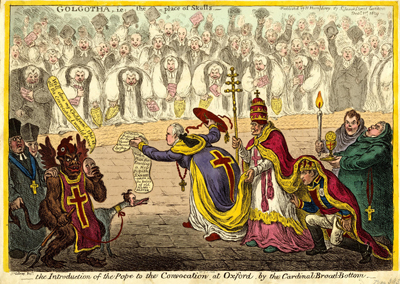The Introduction of the Pope to the Convocation at Oxford. . .
The Introduction of the Pope to the Convocation at Oxford. . . shows Gillray's predictably jaundiced view of the implications of selecting William Grenville for the recently vacated position of Chancellor of Oxford University.

[December 1, 1809]
© Trustees of the British Museum
In late October 1809, the Duke of Portland passed away. In addition to being Prime Minister until shortly before his death, Portland was the Chancellor of Oxford University. So when he died, there was now that vacancy to be filled. Consequently, in mid-November, Dr. Parsons, the Vice-Chancellor of the University announced that a Convocation would be held, for the purpose of selecting a Chancellor. Three candidates were put forward for consideration at the Convocation which was to be held on December 13 and 14: the Duke of Beaufort, Lord Eldon, and William Grenville.
According to London Star of November 17, 1809, the qualifications for the Chancellorship were generally understood to include belonging to an ancient noble family, dignity of personal character, literary abilities, moral worth, and attachment to the Constitution in Church and State.
Almost immediately after the announcement, the jockeying for position began. Beaufort, though of ancient family and possessing "political and moral integrity," was considered "fitter for the sports of the field, and for convivial meetings, than for the Presidency over a learned body." Eldon had been serving as Lord High Chancellor in the Portland administration, but did not come from an ancient family. And rumors were circulated shortly before the vote, allegedly by the Grenville faction, that Eldon had withdrawn his name from consideration. Former Foreign Secretary under Pitt, and former Prime Minister in the Ministry of All the Talents, William Grenville had the requisite family, character, moral worth, and literary abilities. But he also had a history of supporting Catholic Emancipation which was anathema to Eldon's supporters who painted Grenville's candidacy as a threat to both Church and State.
From his earliest prints like Grace before Meat or a Peep at Lord Peter's 1778 to more recent ones like End of the Irish Farce of Catholic Emancipation (1805), Gillray consistently opposed loosening the restrictions on Catholics. Here, in The Introduction..., Gillray (never loathe to portray the worst possible outcomes when Catholics were concerned) suggests that the selection of Grenville as Chancellor is tantamount to turning over the Church to the Pope and the State to the French Emperor Napoleon Buonaparte. And to make his point even more dramatic, Gillray sets the convocation in the delegates room at Clarendon House, Oxford which was familiarly called Golgotha, the Place of the Skulls because the "heads" of the various houses met there. The convocation is, then, a virtual crucifixion.
As in Gillray's earlier Charon's Boat... Grenville is portrayed as a Cardinal in the Catholic Church, this time presenting to the Convocation a "Petition for the Vacant Chancellorship with a Plan for Erecting a Popish Sanhedrim on the Ruins of old Alma Mater." Attached to the skirts of Grenville's robes are the Pope himself and only partly concealed within the Pope's robe the Emperor Napoleon whose coronation the Pope had conspicuously attended.
Some of the Bishops at the Convocation are portrayed as already supportive of this "Popish" plan holding "Mass Books" in their hands as they return the obeisance of Grenville. They include (from left to right) the Bishops of York, St. Asaph, London, Oxford, and Norwich, all of whom lobbied for Grenville's selection.
Naturally (from Gillray's point of view), the Devil is delighted with these proceedings. Wearing a French bonnet rouge and a surplice similar to Grenville's, he can remove his mask and openly exclaim "Well done my Children! This is all the Convocation I would have." Behind him with his hand on the Devil's shoulder is another member of the extended Grenville family—George Nugent-Temple-Grenville, 1st Marquess of Buckingham dressed as a Catholic cleric. Before them on the Devil's leash is Charles Grey, whom Gillray often portrays as an attack dog for Whig policies since he was often their Parliamentary spokesperson. (See Stealing off, or Prudent Secession.)
Since the cause of Catholic Emancipation was practically a family affair, we see two more members of the extended Grenville family, Richard and Thomas, behind the Pope, dressed as monks and holding a lighted candle and a chalice. With this proliferation of Grenvilles in the Introduction..., Gillray not only satirizes the whole family as, in effect, crypto-Catholics, but also takes a swipe at their tendency to accumulate offices and titles and, once in office, reward their kin.
In the end, however, Gillray's attack was not successful. Though the vote was close, Grenville was named Chancellor, receiving 406 votes to Eldon's 393, and Beaufort's 288.
Sources and Reading
- Commentary from the British Museum on The Introduction of the Pope to the Convocation at Oxford.
- Draper Hill, Mr. Gillray The Caricaturist, 1965, p. 130n
- "William Grenville, 1st Baron Grenville," Wikipedia
- "Richard Temple-Nugent-Brydges-Chandos-Grenville, 1st Duke of Buckingham and Chandos," Wikipedia
- "George Nugent-Temple-Grenville, 1st Marquess of Buckingham," Wikipedia
- "Thomas Grenville," Wikipedia
- "Charles Grey, 2nd Earl Grey," Wikipedia
- "John Scott, 1st Earl of Eldon," Wikipedia
- "Henry Somerset, 6th Duke of Beaufort," Wikipedia
- "Catholic emancipation," Wikipedia
- The Clarendon Building, Oxford Conservation Plan, April 2013 p. 40.
- Thomas Wright and R.H. Evans, Historical and Descriptive Account of the Caricatures of James Gillray #356.
- Thomas Wright and Joseph Grego, The Works of James Gillray, the Caricaturist; With the History of His Life and Times, p. 367 .
Comments & Corrections
NOTE: Comments and/or corrections are always appreciated. To make that easier, I have included a form below that you can use. I promise never to share any of the info provided without your express permission.